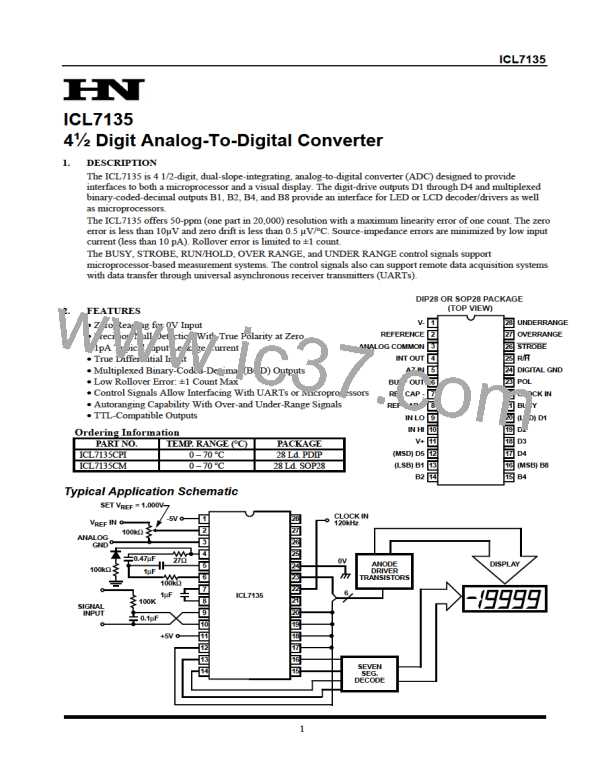ICL7135
10. SYSTEM ASPECTS
• Integrating Resistor
The value of the integrating resistor (RINT) is determined by the full-scale input voltage and the output current of the
integrating amplifier. The integrating amplifier can supply 20 µA of current with negligible nonlinearity. The
equation for determining the value of this resistor is:
FullScaleV oltage
R
=
INT
I
INT
Integrating amplifier current, IINT, from 5 to 40µA yields good results. However, the nominal and recommended current
is 20µA.
• Integrating Capacitor
The product of the integrating resistor and capacitor should be selected to give the maximum voltage swing without
causing the integrating amplifier output to saturate and get too close to the power supply voltages. When the amplifier
output is within 0.3V of either supply, saturation occurs. With ±5V supplies and ANALOG COMMON connected to
ground, the designer should design for a ±3.5V to ±4V integrating amplifier swing. A nominal capacitor value is 0.47
µF. The equation for determining the value of the integrating capacitor (CINT) is:
10000× Clock Peruiod × I
INT
C
=
INT
Integrator Output Voltage Swing
where IINT is nominally 20µA.
Capacitors with large tolerances and high dielectric absorption can induce conversion inaccuracies. A capacitor that is
too small could cause the integrating amplifier to saturate. High dielectric absorption causes the effective capacitor
value to be different during the signal integrate and deintegrate phases. Polypropylene capacitors have very low
dielectric absorption. Polystyrene and polycarbonate capacitors have higher dielectric absorption, but also work well.
• Auto-Zero and Reference Capacitor
Large capacitors tend to reduce noise in the system. Dielectric absorption is unimportant except during power up or
overload recovery. Typical values are 1µF.
• Reference Voltage
For high-accuracy absolute measurements, a high quality reference should be used.
• Rollover Resistor and Diode
The ICL7135 has a small rollover error; however, it can be corrected. The correction is to connect the cathode of any
silicon diode to INT OUT and the anode to a resistor. The other end of the resistor is connected to ANLG COMMON or
ground. For the recommended operating conditions, the resistor value is 100kΩ. This value may be changed to correct
any rollover error that has not been corrected. In many non-critical applications the resistor and diode are not needed.
• Maximum Clock Frequency
For most dual-slope A/D converters, the maximum conversion rate is limited by the frequency response of the
comparator. In this circuit, the comparator follows the integrator ramp with a 3-µs delay. Therefore, with a 160kHz
clock frequency (6-µs period), half of the first reference integrate clock period is lost in delay. Hence, the meter reading
changes from 0 to 1 with a 50µV input, 1 to 2 with a 150µV input, 2 to 3 with a 250µV input, etc. This transition at
midpoint is desirable; however, when the clock frequency is increased appreciably above 160kHz, the instrument
flashes 1 on noise peaks even when the input is shorted. The above transition points assume a 2V input range is
equivalent to 20000 clock cycles.
When the input signal is always of one polarity, comparator delay need not be a limitation. Clock rates of 1MHz are
possible since nonlinearity and noise do not increase substantially with frequency. For a fixed clock frequency, the extra
count or counts caused by comparator delay are a constant and can be subtracted out digitally.
For signals with both polarities, the clock frequency can be extended above 160kHz without error by using a low value
resistor in series with the integrating capacitor. This resistor causes the integrator to jump slightly towards the zero-
crossing level at the beginning of the deintegrate phase, and thus compensates for the comparator delay. This series
resistor should be 10Ω to 50Ω . This approach allows clock frequencies up to 480kHz.
7

 HN [ NANJING HONANO ELECTRONIC CO., LTD. ]
HN [ NANJING HONANO ELECTRONIC CO., LTD. ]